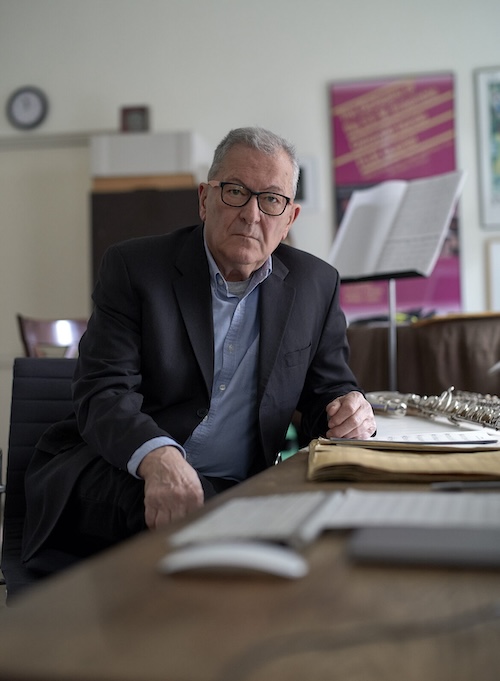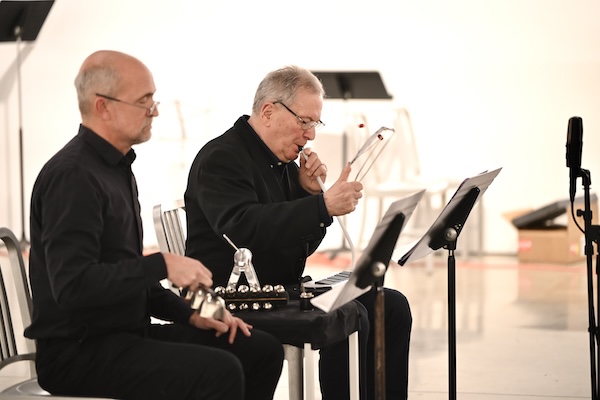S.E.M. Ensemble brings holiday gifts with new music by Kotik, Mrkvíčka

This year of Czech music wrapped up Wednesday night at the Paula Cooper Gallery with an invigorating reminder of how important that country’s musical culture has been to modern American classical music.
The occasion was the annual winter concert from the S. E. M. Ensemble, directed by Petr Kotik. For over 50 years, the ensemble, formed by Kotik, has been at the forefront of modernist and avant-garde music. Kotik, a notable composer himself, was an important colleague to John Cage and Morton Feldman, and has been one of the finest interpreters of their work.
Cage and Feldman were on the program Wednesday, as was a world premiere from Kotik. With guest performers soprano-composer Kamala Sankaram and violinist Pauline Harris Kim, the ensemble also played a recent piece from Anna Heflin (a violist in S.E.M.), Czech composer Luboš Mrkvíčka, and music from the important and under-appreciated mid-20ᵗʰ century Czech composer Rudolf Komorous.
The Cage and Feldman selections were some of their most prominent music. The night opened with Cage’s Concert for Orchestra, the stand-alone ensemble part of the Concert for Piano. It’s one of several Cage pieces that can be played simultaneously with some of his other works, and Wednesday night that was Aria, sung by Sankaram.
This is the strain of Cage’s music that is as much about the listener as the composer and musicians, but it still takes a focused, skillful performance to play what are 13 separate solos. The musicians work with time—Kotik was a human clock for this—and the musical material is a combination of relative pitch and dynamics and as wide a range of instrumental technique as possible. Meanwhile, Aria uses graphic notation and combines words (in multiple languages) and vocal sounds.
With Sankaram first initiating Aria, the playing felt a bit effortful and brittle at first, as if everyone was thinking through the rules, tense about their next entrance. But after a few minutes, a calm focus settled over the ensemble and everything was relaxed and chiseled, with more natural and vibrant playing. There were aggressively imaginative contributions from clarinetist David Valbuena, bassoonist/ saxophonist Chris Foss, and tuba player Ben Stapp. In the end this was vintage S.E.M.
Heflin’s The man who owned the forest also owned the racetrack. This philosophical mashup of musical ideas, and two duos—violin and flute with bass clarinet and cello—all underneath a solo trumpet, proved a frustrating work. There were fascinating phrases that turned baroque ideas into avant-garde gestures, but also ones that seemed aimless. Trumpeter Sam Jones floated above this all with his own discontinuous part. Nothing seemed entirely connected nor entirely opposed, a noncommittal feeling that produced obscurity without expressive or aesthetic density.
Mrkvíčka’s Quartet, Part A, for violin, cello, flute, and bass clarinet, was a marvelous little piece with a fluttering, shifting quality. This wasn’t music that followed a linear path of phrases to create form, but more an accumulation of mysterious and charming sonic events, like a swarm of butterflies that alighted for a brief visit. Quiet, sensual, intellectually and expressively quick, this was an excellent experience.

After intermission came Komorous’s Olympia. Kotik introduced it by making the point that Komorous was a serious composer, which was wise because the instrumentation for this duo (Kotik playing flexitone and melodica, percussionist Chris Nappi wielding bells and birdcalls) would have had an unprepared audience guffawing defensive nervousness. This was indeed a serious, disciplined, well-crafted work that used unusual instruments in place of those with more familiar timbres or pitches. With a strong, elegant structure, dramatic amounts of space, and subtle surprises, this was a masterpiece of modest dimensions and deep possibilities.
With Kotik cueing, violinists Conrad Harris and Theresa Salamon, violist Liuh-Wen Ting, and cellist Ben Larsen delivered a superb performance of Feldman’s Structures. Dynamics and rhythms were finely etched, and the players’ intonation and timbres were beautiful. This was an ideal companion to Cage’s music, and an equally ideal prelude to the finale.
That was another mash-up, Kotik’s brand new Why Melody? (was it named after Feldman’s Why Patterns?), overlaid with Sankaram performing excerpts from his Gertrude Stein works Master-Pieces and There is Singularly Nothing. Inside all this were solos for violin and viola that Kotik composed earlier this year (one played by Kim in duo with Sankaram, the others within the ensemble).
What may seem complicated on paper was clear and focused live. Why Melody? is a unison solo line for an ensemble, doubling back on itself via short phrases and with little idiosyncratic twists in Kotik’s typical style. The solos emerged seamlessly from this and added additional interest to this compelling music. The vocal excerpts were succinct while adding even more facets to what was a kaleidoscopic night of modernist and Czech colors.